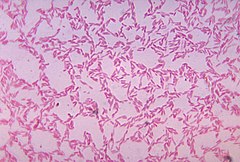Bacteroides
| Bacteroides | |
|---|---|

| |
| Bacteroides spp. anaerobically cultured in blood agar medium. | |
| Scientific classification | |
| Kingdom: | |
| Phylum: | |
| Class: | |
| Order: | |
| Family: | |
| Genus: | Bacteroides Castellani & Chalmers 1919
|
| Species | |
|
B. acidifaciens | |
Bacteroides is a genus of Gram-negative, bacillus bacteria. Bacteroides species are non-endospore-forming, anaerobes, and may be either motile or non-motile, depending on the species.[1] The DNA base composition is 40-48% GC. Unusual in bacterial organisms, Bacteroides membranes contain sphingolipids. They also contain meso-diaminopimelic acid in their peptidoglycan layer.
Bacteroides are normally mutualistic, making up the most substantial portion of the mammalian gastrointestinal flora,[2] where they play a fundamental role in processing of complex molecules to simpler ones in the host intestine.[3][4][5] As many as 1010-1011 cells per gram of human feces have been reported.[6] They can use simple sugars when available, but the main source of energy is polysaccharides from plant sources.
One of the most important clinically is Bacteroides fragilis.
Bacteroides melaninogenicus has recently been reclassified and split into Prevotella melaninogenica and Prevotella intermedia.[7]
Pathogenesis
Bacteroides species also benefit their host by excluding potential pathogens from colonizing the gut. Some species (B. fragilis, for example) are opportunistic human pathogens, causing infections of the peritoneal cavity, gastrointestinal surgery, and appendicitis via abscess formation, inhibiting phagocytosis, and inactivating beta-lactam antibiotics.[8] Although Bacteroides species are anaerobic, they are aerotolerant and thus can survive in the abdominal cavity.
In general, Bacteroides are resistant to a wide variety of antibiotics — β-lactams, aminoglycosides, and recently many species have acquired resistance to erythromycin and tetracycline. This high level of antibiotic resistance has prompted concerns that Bacteroides species may become a reservoir for resistance in other, more highly-pathogenic bacterial strains.[9] [10]
Microbiological Applications
An alternative fecal indicator organism, Bacteroides, has been suggested because they make up a significant portion of the fecal bacterial population[11], have a high degree of host specificity that reflects differences in the digestive system of the host animal[12], and have a small potential to grow in the environment[13]. Over the past decade, real-time polymerase chain reaction (PCR) methods have been utilized to detect the presence of various microbial pathogens through the amplification of specific DNA sequences without culturing bacteria. One study has measured the amount of Bacteroides by using qPCR to quantify the 16S rRNA genetic marker that is host-specific.[14] This technique allows quantification of genetic markers that are specific to the host of the bacteria and allow detection of recent contamination. A recent report found that temperature plays a major role in the amount of time the bacteria will persist in the environment, the life span increases with colder temperatures (0-4C)[15]
See also
References
- ^ Madigan M, Martinko J (editors). (2005). Brock Biology of Microorganisms (11th ed.). Prentice Hall. ISBN 0-13-144329-1.
{{cite book}}:|author=has generic name (help) - ^ Dorland WAN (editor) (2003). Dorland's Illustrated Medical Dictionary (30th ed.). W.B. Saunders. ISBN 0-7216-0146-4.
{{cite book}}:|author=has generic name (help) - ^ Attention: This template ({{cite doi}}) is deprecated. To cite the publication identified by doi:10.1128/CMR.00008-07 , please use {{cite journal}} (if it was published in a bona fide academic journal, otherwise {{cite report}} with
|doi=10.1128/CMR.00008-07instead. - ^ Attention: This template ({{cite doi}}) is deprecated. To cite the publication identified by doi:10.1073/pnas.1734063100 , please use {{cite journal}} (if it was published in a bona fide academic journal, otherwise {{cite report}} with
|doi=10.1073/pnas.1734063100instead. - ^ Attention: This template ({{cite doi}}) is deprecated. To cite the publication identified by doi:10.1371/journal.pbio.0050156 , please use {{cite journal}} (if it was published in a bona fide academic journal, otherwise {{cite report}} with
|doi=10.1371/journal.pbio.0050156instead. - ^ Finegold SM, Sutter VL, Mathisen GE (1983). Normal indigenous intestinal flora (pp. 3-31) in Human intestinal microflora in health and disease. Academic Press. ISBN 0-12-341280-3.
{{cite book}}: CS1 maint: multiple names: authors list (link) - ^ "Bacteroides Infection: Overview - eMedicine". Retrieved 2008-12-11.
- ^ Ryan KJ, Ray CG (editors) (2004). Sherris Medical Microbiology (4th ed.). McGraw Hill. ISBN 0-8385-8529-9.
{{cite book}}:|author=has generic name (help) - ^ Salyers AA, Gupta A, Wang Y (2004). "Human intestinal bacteria as reservoirs for antibiotic resistance genes". Trends Microbiol. 12 (9): 412–6. doi:10.1016/j.tim.2004.07.004. PMID 15337162.
{{cite journal}}: CS1 maint: multiple names: authors list (link) - ^ Attention: This template ({{cite doi}}) is deprecated. To cite the publication identified by doi:10.1093/jac/dkl420 , please use {{cite journal}} (if it was published in a bona fide academic journal, otherwise {{cite report}} with
|doi=10.1093/jac/dkl420instead. - ^ Madigan M, Martinko J (editors). (2005). Brock Biology of Microorganisms (11th ed.). Prentice Hall. ISBN 0-13-144329-1.
{{cite book}}:|author=has generic name (help) - ^ Bernhard and Field, A.E. and K.G.; Field, KG (2000). "A PCR Assay To Discriminate Human and Ruminant Feces on the Basis of Host Differences in Bacteroides-Prevotella Genes Encoding 16S rRNA". Applied and Environmental Microbiology. 66 (10): 4571–4574. doi:http://water.rutgers.edu/Source_Tracking/Bacteroidetes/APCRAssayToDiscriminateHumanandRuminantFecesontheBasisofHostDifferencesinBacteroides.pdf. PMC 92346. PMID 11010920.
{{cite journal}}: Check|doi=value (help); External link in|doi= - ^ Kreader, C.A. (1998). "Persistence of PCR-Detectable Bacteroides distasonis from Human Feces in River Water". Applied and Environmental Microbiology. 64 (10): 4103–4105. doi:http://www.water.rutgers.edu/Source_Tracking/Bacteroidetes/PersistenceofPCR-DetectableBacteroidesdistasonisfromHumanFecesinRiverWater.pdf. PMC 106613. PMID 9758854.
{{cite journal}}: Check|doi=value (help); External link in|doi= - ^ Layton, A.; McKay, L; Williams, D; Garrett, V; Gentry, R; Sayler, G (2006). "Development of Bacteroides 16S rRNA Gene TaqMan-Based Real-Time PCR Assays for Estimation of Total, Human,and Bovine Fecal Pollution in Water". Applied and Environmental Microbiology. 72 (6): 4214–4224. doi:http://aem.asm.org/cgi/content/short/72/6/4214. PMC 1489674. PMID 16751534.
{{cite journal}}: Check|doi=value (help); External link in|doi= - ^ Bell, Layton, McKay, Williams, Gentry, Sayler, A., A.C., L., D., R., G.S.; Layton, Alice C.; McKay, Larry; Williams, Dan; Gentry, Randy; Sayler, Gary S. (2009). "Factors Influencing the Persistance of Fecal Bacteroides in Stream Water". J. Environ. Qual. 38 (3): 1224–1232. doi:10.2134/jeq2008.0258. PMID 19398520.
{{cite journal}}: CS1 maint: multiple names: authors list (link)
External links
- Bacteroides infections in E Medicine
- Bacteroides in detail.
